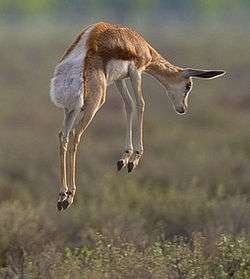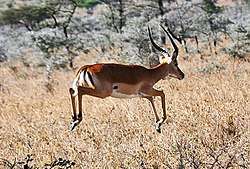Stotting
Stotting (also called pronking or pronging) is a behavior of quadrupeds, particularly gazelles, in which they spring into the air, lifting all four feet off the ground simultaneously. Usually, the legs are held in a relatively stiff position.[1] Many explanations of stotting have been proposed; there is evidence that at least in some cases it is an honest signal to predators that the stotting animal would be difficult to catch.[1]

Etymology
Stot is a common Scots and Northern England verb meaning "bounce" or "walk with a bounce".[2] Uses in this sense include stotting a ball off a wall, and rain stotting off a pavement. Pronking comes from the Afrikaans verb pronk-, which means "show off" or "strut", and is a cognate of the English verb "prance".[3]
Occurrence
Stotting occurs in several deer species of North America, including mule deer, pronghorn,[4] and Columbian black-tailed deer, when a predator is particularly threatening,[5] and in a variety of ungulate species from Africa, including Thomson's gazelle and springbok.[6] It is also said to occur in the blackbuck, a species found in India.[7]
Stotting occurs in domesticated livestock such as sheep and goats, where it is typically performed only by young animals.[8]
Possible explanations
Stotting makes a prey animal more visible,[9] and uses up time and energy that could be spent on escaping from the predator. Since it is dangerous, the continued performance of stotting by prey animals must bring some benefit to the animal (or its family group) performing the behavior. A number of possible explanations have been proposed for stotting.[10][11] Stotting may be:
- A good means of rapid escape or jumping over obstructions. However, this cannot be true in Thomson's gazelles because these prey animals do not stot when a predator is less than approximately 40 m away.[6][12]
- An anti-ambush behavior; animals living in tall grass may leap into the air to detect potential predators.[10]
- An alarm signal to other members of the herd that a predator is hazardously close thereby increasing the survival rate of the herd.[lower-alpha 1][10]
- A socially cohesive behavior to escape predators by coordinated stotting, thereby making it more difficult for a predator to target any individual during an attack (much like the suggestion that zebra stripes cause motion dazzle).[10]
- An honest signal of the animal's fitness. Stotting could be a way of deterring pursuit by warning a predator of the animal's unsuitability as prey: the prey benefits by not being chased (because it is in fact very fit); the predator benefits by not wasting time chasing an animal it is unlikely to catch. This signalling explanation avoids the group selection connotations of the "alarm signal" and "socially cohesive" escape hypotheses.[10][12]
- An instance of Amotz Zahavi's handicap principle, whereby stotting is signalling to predators that the animal is so fit it can escape even if it deliberately slows itself down with some apparently useless behavior (i.e. stotting).[13]
- A predator detection signal whereby the animal signals to the predator that it has been seen and therefore does not have the advantage of surprise. Many such signals exist in different groups of animals. Again, this would be an honest pursuit deterrence signal, benefiting the prey by not being chased (because it can be seen to be aware of the predator and ready to escape immediately) and benefitting the predator by not wasting time stalking prey when it has already been seen. Evidence for this hypothesis is that cheetahs abandon more hunts when their gazelle prey stots, and when they do give chase to a stotting gazelle, they are far less likely to make a kill.[11] However, gazelles stot less often to cheetahs (which stalk and would therefore probably give up when detected) than to African wild dogs, which "course" (chase prey relentlessly, not relying on surprise).[12]
- A fitness display to potential mates in a sexual selection process rather than an antipredator adaptation.[14]
- Play, especially in young animals, which may help to prepare them for adult life. In favor of this hypothesis, stotting is sometimes observed in immature animals; against this is the fact that stotting is generally seen in adult prey responding to predators.[12]
The English evolutionary biologist John Maynard Smith concludes that "the natural explanation is that stotting is an index of condition and of escape capability", used as a signal especially to coursing predators. He also observes that "it is hard to see how it could be a handicap", unless perhaps it is a signal to other gazelles of the same species.[6]
Notes
- This would be an instance of group selection.
References
- FitzGibbon, C.D; Fanshawe, J.H (1988). "Stotting in Thomson's gazelles: an honest signal of condition". Behavioral Ecology and Sociobiology. 23 (2): 69–74. doi:10.1007/BF00299889.
- "Definition of stot". www.allwords.com.
- "Definition of pronk". www.allwords.com.
- Roosevelt, Theodore (1905). Outdoor Pastimes of an American Hunter. C. Scribner's Sons.
- Stankowich, Theodore; Coss, Richard (2007). "Effects of Risk Assessment, Predator Behavior, and Habitat on Escape Behavior in Columbian Black-Tailed Deer". Behavioral Ecology. 18 (2): 358–367. doi:10.1093/beheco/arl086.
- Maynard Smith, John; Harper, David (2003). Animal Signals. Oxford University Press. pp. 61–63 .
- Schaller, George B. (1984) [1967]. The deer and the tiger : a study of wildlife in India. Chicago: University of Chicago Press. p. 158. ISBN 9780226736570. OCLC 550640864.
- Simmons, Paula; Ekarius, Carol (2001). Storey's Guide to Raising Sheep. North Adams, Massachusetts: Storey Publishing. ISBN 978-1-58017-262-2.
- Anon (19 June 1986). "How the cheetah lost its stotts". New Scientist: 34.
- Alcock, J. (2009). Animal Behavior. (Ninth ed.). Massachusetts: Sinauer
- Caro, T. M. (1986). "The functions of stotting in Thomson's gazelles: Some tests of the predictions". Animal Behaviour. 34 (3): 663–684. doi:10.1016/S0003-3472(86)80052-5.
- FitzGibbon, C. D.; Fanshawe, J. H. (August 1988). "Stotting in Thomson's gazelles: an honest signal of condition". Behavioral Ecology and Sociobiology. 23 (2): 69–74. doi:10.1007/bf00299889.
- Zahavi, Amotz (1997). The Handicap Principle: A Missing Piece of Darwin's Puzzle. Oxford: Oxford University Press. ISBN 0-19-510035-2.
- Herbivores of the Pilanesberg National Park I Archived 2011-07-15 at the Wayback Machine, South African Lodges
External links
| Look up stot or pronk in Wiktionary, the free dictionary. |
| Look up stotting or stott in Wiktionary, the free dictionary. |


